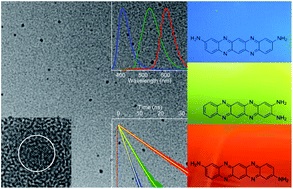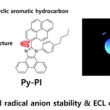댓글 쓰기 권한이 없습니다. 로그인 하시겠습니까?
Distinctive optical transitions of tunable multicolor carbon dots
| Journal | Nanoscale Advances |
|---|---|
| Author | Hyeong Seop Shim, Jun Myung Kim, Seonghyun Jeong, Youngwon Ju, Sung Jae Won, Jeongyun Choi, Sangwon Nam, Aniruddha Molla, Joohoon Kim* and Jae Kyu Song* |
| Citation | Nanoscale Adv., 2022,4, 1351-1358 |
| DOI | https://doi.org/10.1039/D1NA00811K |

Three types of carbon dots (CDs) are synthesized from isomers of phenylenediamine to develop multicolor
nanomaterials with low toxicity, high stability, and high quantum yield. The distinctive electronic structures
of CDs lead to the characteristic optical transitions, such as three colors of blue, green, and red, which are
primarily attributed to the difference in configurations, despite the similar basic structures of conjugated
systems. The excitation-independent emission and the single exponential decay of CDs indicate the
single chromophore-like nature in each type of CD. In addition, the two-photon luminescence of CDs
exhibits a comparable shape and time profile to the typical photoluminescence with high photostability.
Although the surface-related defect states are observed by intragap excitation, the contribution of defect
states is barely observed in the emission profile upon band gap excitation. Consequently, the
controllability of optical transitions in CDs enhances the potential of tunable multicolor nanomaterials for
various applications as alternatives to quantum dots containing toxic elements.
-
Read More

Three-Dimensional TEM Study of Dendrimer-Encapsulated Pt Nanoparticles for Visualizing Structural Characteristics of the Whole Organic-Inorganic Hybrid Nanostructure
Category2021 AuthorYoungwon Ju, Hyun Joo Ro, Yoon Sun Yi, Taehoon Cho, Seung Il Kim, Chang Won Yoon, Sangmi Jun, Joohoon Kim JournalThree-Dimensional TEM Study of Dendrimer-Encapsulated Pt Nanoparticles for Visualizing Structural Characteristics of the Whole Organic-Inorganic Hybrid Nanostructure CitationAnal. Chem. 2021, 93, 5, 2871?2878
-
Read More

Intrinsic size-dependent activity of Pt nanoparticles without masking by heterogeneous oxidation states of Pt for hydrolytic dehydrogenation of NH3BH3
Category2022 AuthorYoungwon Ju,Taehoon Cho,Kichul Lee,Jiwoong Kim,Chang Won Yoon,Joohoon Kim JournalInt J. Energy Research CitationInt J Energy Res.2022;46:9771?9781
-
Read More

Enhanced near-infrared electrochemiluminescence of Au nanoclusters treated with piperidine
Category2022 AuthorJae Hyun Kim, Jeongyun Choi, Jiwoo Kim, Joohoon Kim JournalBioelectrochemistry CitationBioelectrochemistry 147 (2022) 1
-
Read More

Efficient blue organic electrochemiluminescence luminophore based on a pyrenyl-phenanthroimidazole conjugate
Category2022 AuthorKwang-Myeong Kim, Jiwoo Kim, Joohoon Kim*, Jong-In Hong* JournalChemical Communications CitationChem. Commun., 2022, 58, 7542
-
Read More

Distinctive optical transitions of tunable multicolor carbon dots
Category2022 AuthorHyeong Seop Shim, Jun Myung Kim, Seonghyun Jeong, Youngwon Ju, Sung Jae Won, Jeongyun Choi, Sangwon Nam, Aniruddha Molla, Joohoon Kim* and Jae Kyu Song* JournalNanoscale Advances CitationNanoscale Adv., 2022,4, 1351-1358
Designed by sketchbooks.co.kr / sketchbook5 board skin
Sketchbook5, 스케치북5
Sketchbook5, 스케치북5
Sketchbook5, 스케치북5
Sketchbook5, 스케치북5
.png)


 Efficient blue organic electrochemiluminescence lumin...
Efficient blue organic electrochemiluminescence lumin...